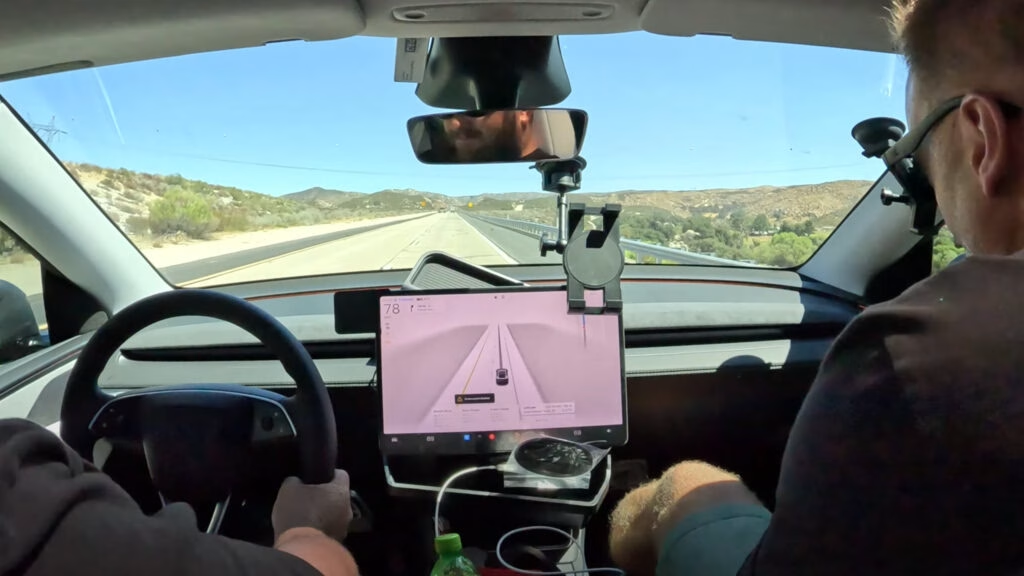Why Did a Tesla Model Y Crash Into a Steel Ramp While Using Full Self-Driving?
Picture this: you’re cruising down the highway at 76 mph, hands lightly on the wheel, Tesla’s Full Self-Driving (FSD) system humming along. Suddenly, there’s something up ahead in the road. Is it roadkill? A stray tire? For two Tesla enthusiasts attempting a cross-country trek from Los Angeles to Jacksonville, Florida, it turned out to be a steel ramp—one that had likely fallen off a truck and landed squarely in their path.
Despite having a clear eight-second warning, neither the driver nor the FSD system reacted in time. The Model Y plowed into the ramp, launching the car briefly airborne before slamming back onto the asphalt. The result? A broken sway bar bracket, damaged suspension, and a front drive unit that was left inoperable. Not exactly the smooth, coast-to-coast journey Tesla’s CEO once promised.
What Really Happened in Those Critical Seconds?
Here’s where things get interesting. The driver and passenger, both self-proclaimed Tesla fans, were relying heavily on the FSD system to detect and avoid obstacles. As they approached the object, the passenger guessed it might be roadkill, but neither took decisive action. They seemed to be waiting for the car to make the call.
This isn’t just a story about a missed ramp. It’s a cautionary tale about overconfidence in technology. Tesla’s FSD is classified as Level 2 automation, which means it’s designed to assist—not replace—the human behind the wheel. According to the National Highway Traffic Safety Administration (NHTSA), Level 2 systems require drivers to remain alert and ready to take control at any moment. In this case, both the human and the machine failed to act, leading to a costly and dangerous collision.
How Much Damage Did the Tesla Actually Sustain?
After the crash, the duo pulled over to inspect the car. At first glance, the damage didn’t seem too severe, so they continued driving for several hundred miles before finally stopping at a mechanic. Once the car was lifted, the real extent of the damage became clear: the sway bar bracket was destroyed, several suspension components were bent or broken, and the front drive unit was compromised.
Repairs like these aren’t cheap. A damaged sway bar or suspension can easily run into the thousands, not to mention the potential for hidden issues that only reveal themselves over time. For a car that’s supposed to represent the future of driving, this was a harsh reminder that even the most advanced systems have their limits.
Are Drivers Expecting Too Much From Tesla’s Full Self-Driving?
It’s easy to see why some drivers might get lulled into a false sense of security with FSD. The technology is impressive—navigating city streets, changing lanes, even handling some tricky merges. But as this incident shows, it’s not infallible.
A 2023 study from the Insurance Institute for Highway Safety (IIHS) found that drivers using advanced driver-assistance systems (ADAS) like Tesla’s FSD are more likely to become distracted and less likely to intervene in emergencies. The problem isn’t just the technology—it’s the human tendency to trust it too much.
Tesla’s own documentation makes it clear: FSD is a driver-assist feature, not a replacement for attentive driving. Yet, stories like this one keep cropping up, suggesting that the message isn’t always getting through.
What Can We Learn From This Crash About the Future of Autonomous Driving?
Incidents like the Model Y ramp crash highlight a crucial gap between marketing and reality. While Tesla’s CEO once teased a coast-to-coast autonomous drive, nearly a decade later, that promise remains unfulfilled. Real-world tests—especially those shared by enthusiasts on YouTube—often reveal the rough edges that still need smoothing.
The path to true autonomy is littered with challenges: unpredictable road debris, construction zones, erratic human drivers, and weather conditions that can baffle even the most sophisticated sensors. Until these hurdles are overcome, human vigilance remains the best line of defense.
What Should Tesla Owners Do to Stay Safe With FSD?
If you’re a Tesla owner, or considering becoming one, here’s the bottom line: treat FSD as a helpful co-pilot, not an autopilot. Stay alert. Keep your hands on the wheel and your eyes on the road. Don’t assume the car will handle every surprise—because sometimes, it won’t.
Experts recommend regular practice with manual takeovers and staying up to date on software updates and system limitations. Remember, even the most advanced technology can’t replace good old-fashioned common sense.
The big takeaway? Full Self-Driving isn’t about perfection—it’s about smarter adjustments. Start with one change this week—maybe double-checking your surroundings or practicing a quick manual takeover—and you’ll likely spot the difference by month’s end.

